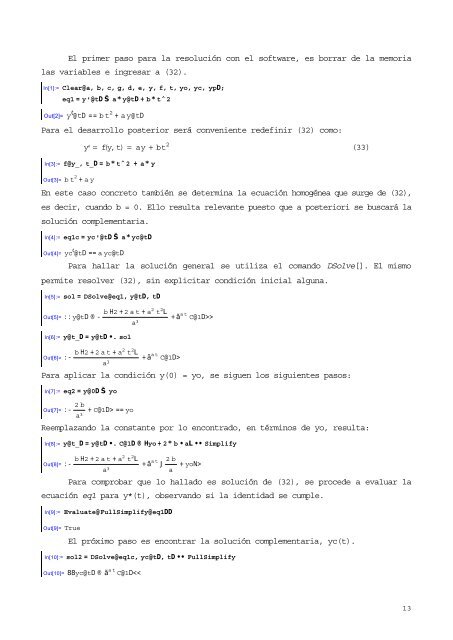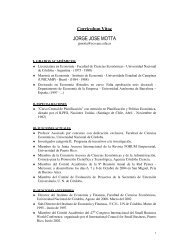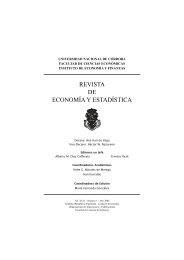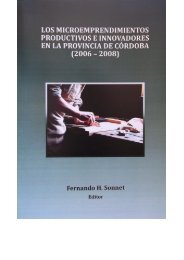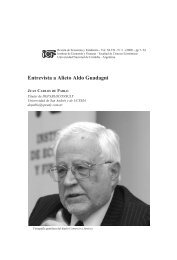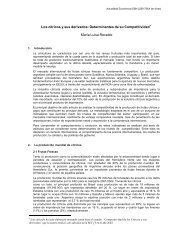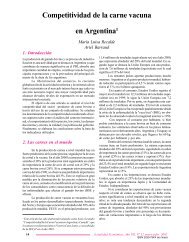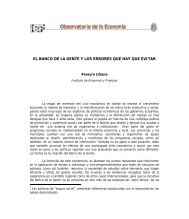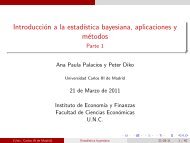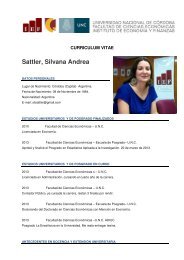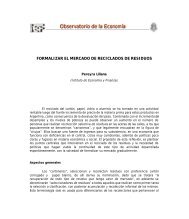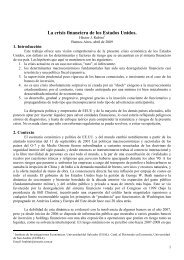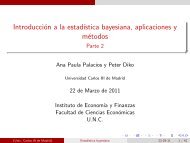Notas sobre ecuaciones diferenciales. Aplicaciones a la TeorÃa del ...
Notas sobre ecuaciones diferenciales. Aplicaciones a la TeorÃa del ...
Notas sobre ecuaciones diferenciales. Aplicaciones a la TeorÃa del ...
Create successful ePaper yourself
Turn your PDF publications into a flip-book with our unique Google optimized e-Paper software.
El primer paso para <strong>la</strong> resolución con el software, es borrar de <strong>la</strong> memoria<strong>la</strong>s variables e ingresar a (32).In[1]:= Clear@a, b, c, g, d, e, y, f, t, yo, yc, ypD;eq1 = y'@tD a *y@tD + b *t^2Out[2]= y ¢ @tD ==bt 2 +ay@tDPara el desarrollo posterior será conveniente redefinir (32) como:2y ' = (fy,t) = ay + bt(33)In[3]:= f@y_, t_D = b *t^2 + a *yOut[3]= bt 2 +ayEn este caso concreto también se determina <strong>la</strong> ecuación homogénea que surge de (32),es decir, cuando b = 0. Ello resulta relevante puesto que a posteriori se buscará <strong>la</strong>solución complementaria.In[4]:= eq1c = yc'@tD a *yc@tDOut[4]= yc ¢ @tD ==ayc@tDPara hal<strong>la</strong>r <strong>la</strong> solución general se utiliza el comando DSolve[]. El mismopermite resolver (32), sin explicitar condición inicial alguna.In[5]:= sol = DSolve@eq1, y@tD, tDOut[5]= ::y@tD fi - b H2 +2at+a2 t 2 La 3+ ª at C@1D>>In[6]:= y@t_D = y@tD . solOut[6]= :- b H2 +2at+a2 t 2 La 3+ ª at C@1D>Para aplicar <strong>la</strong> condición y(0) = yo, se siguen los siguientes pasos:In[7]:= eq2 = y@0D yoOut[7]= :- 2b +C@1D> ==yoa3 Reemp<strong>la</strong>zando <strong>la</strong> constante por lo encontrado, en términos de yo, resulta:In[8]:= y@t_D = y@tD . C@1D fi Hyo +2 *baL SimplifyOut[8]= :- b H2 +2at+a2 t 2 La 3+ ª at J 2ba +yoN>Para comprobar que lo hal<strong>la</strong>do es solución de (32), se procede a evaluar <strong>la</strong>ecuación eq1 para y*(t), observando si <strong>la</strong> identidad se cumple.In[9]:= Evaluate@FullSimplify@eq1DDOut[9]= TrueEl próximo paso es encontrar <strong>la</strong> solución complementaria, yc(t).In[10]:= sol2 = DSolve@eq1c, yc@tD, tD FullSimplifyOut[10]= 88yc@tD fi ª at C@1D


